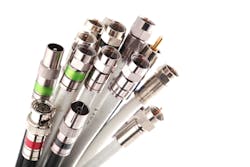CableLabs held a 10G Showcase last week in which Charter Communications and Comcast led demos of DOCSIS 4.0 technology that showed capabilities similar to those of 10G PON -- as well as compatibility with 10G PON. The demos also showed that cable MSOs may be able to deploy the two main versions of DOCSIS 4.0 without “fiber deep” network extensions to remove DOCSIS amplifiers from their networks.
Charter and Comcast have split on their preferences among the two DOCSIS 4.0 flavors. Charter has preferred Extended Spectrum DOCSIS (ESD), which was designed to be used with amplifiers in place, while Comcast has favored Full Duplex DOCSIS (FDX), which was designed for links with no amplifiers between the final node and the customer.
During the showcase, Charter demonstrated an ESD frequency-division duplex (FDD) implementation that combined 1.8-GHz amplifiers in a Node+4 (meaning a node plus four amplifiers) cascade. With the connection set at 684 MHz upstream and 1794 MHz downstream, Charter showed the ability to support 8.9 Gbps downstream and 6.2 Gbps upstream using 4K QAM modulation. John Williams, vice president of engineering at Charter, said the service provider believes it can employ ESD in links with a greater number of amplifiers, but that Node+4 is typical in Charter’s network.
Comcast was next up with a multi-faceted demonstration of FDX that leveraged the company’s virtual CMTS core. The demonstration covered the delivery of high-speed broadband (approximately 8.5 Gbps downstream and 5 Gbps upstream) via 2K QAM. Rob Howald, Comcast Fellow and vice president of network architecture at Comcast, said that 2K QAM is what Comcast uses currently but that 4K QAM capabilities will be coming in a few months. The demo network distributed capacity to a pair of DOCSIS 4.0 cable modems. Howald showed how the operator could quickly adjust the capacity distributed to each modem.
Another demo used the same vCMTS core with a DOCSIS 3.1 node to support 10G PON via a five-port remote OLT module within the node. Howald said Comcast was seeing around 7.6 Gbps symmetrically in such a setup.
However, Howald raised the most eyebrows when he showed off prototype FDX amplifiers capable of enabling FDX transmission in Node+2 architectures. He said that Comcast will release more details of this work in the second half of this year. However, Elad Nafshi, executive vice president and chief network officer at Comcast Cable, stated that the company is targeting the ability to support Node+6.
The demos bode well for operators who want to upgrade their HFC architectures with DOCSIS 4.0 – if they’re willing to wait for technology availability. Curtis Knittle, vice president of wired technologies at CableLabs, said the demos loosely represented the organization’s first DOCSIS 4.0 technology interop – although it is his expectation that more DOCSIS 4.0 technology will be ready for such exercises later this year.
More life in HFC
The demonstrations also signaled that deploying DOCSIS 4.0 might be easier and more straightforward, particularly in terms of minimizing tap and amplifier relocation, than previously believed, Jeff Heynen, vice president and head of Dell’Oro Group’s Broadband Access and Home Networking market research program, wrote in a blog. However, he remains concerned about the pace of technology commercialization in the current constrained environment.
“The net result of both technology demonstrations is that any concerns around the value of upgrading to DOCSIS 4.0 relative to the cost are now taken off the table,” he wrote. “Instead, the question now shifts to one of timing. Operators around the world were firmly in the camp of one technology or the other, with all agreeing that some level of fiber would be a major part of any future network upgrade. Now, operators have two similarly performing technology options in front of them, each requiring upgrading of existing amplifiers, but with two very large questions around timing and availability of key components.”
However, he noted that the DOCSIS 4.0 technology demonstrated during the event showed that cable MSOs won’t necessarily have to switch to an all-fiber approach to keep pace with PON-based telco networks. “[A]fter today’s demonstrations, the value and relevance of DOCSIS 4.0 just improved significantly. With theoretical speeds matching those offered by today’s XGS-PON technologies, cable operators can easily buy themselves more time and continue to maximize their DOCSIS networks for many years to come,” he concluded.
For related articles, visit the FTTx Topic Center.
For more information on FTTx technology and suppliers, visit the Lightwave Buyer’s Guide.
To stay abreast of fiber network deployments, subscribe to Lightwave’s Service Providers and Datacom/Data Center newsletters.
